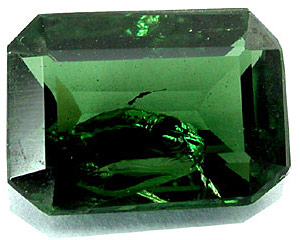| Crystal system | Cubic |
| Transparency | Transparent to opaque |
| Luster | Vitreous |
| Fracture | Conchoidal |
| Cleavage | Indistinct |
| Specific Gravity | 4.0-4.6 |
| Hardness | 7.5 |
| Optical Character | Isometric |
| Refractive index | 1.80 |
| Birefringence | |
| Dispersion | |
| Fluorescence | |
| Pleochroism | |
| Chemical Formula | ZnAl2O4 |
| Comments | Not attached by acids |
| Streak | uncolored |
Gahnite (GAHN-ite) is a zinc-spinel (ZnAl2O4) which was named for F. G. Gahn (1745 - 1818), the Swedish chemist. It is a member of the spinel group; when all the magnesium in spinel's composition is replaced by zinc, the mineral is then gahnite (zinc aluminum oxide), with increased property values (both the refractive index and specific gravity are higher than spinel's). Gahnite has been made synthetically with the following properties: R.I. 1.82; Hardness 7 1/2; S.G. 4.6.
Color ranges of gahnite are from yellow to green, brown and greenish black. Gahnite crystallizes in the cubic system and generally forms in the octahedral habit. Usually gahnite is too dark in color to be effective as a gemstone, but occasionally some very nice green specimens appear. The source of faceted gem material in the past is not certain, although it was probably Brazil. Very recently, rough material of a nice peridot green from Brazil has appeared.
Directions for faceting and polishing are the same as those for spinel, with crown angles of 37° and pavilion, 42°.


